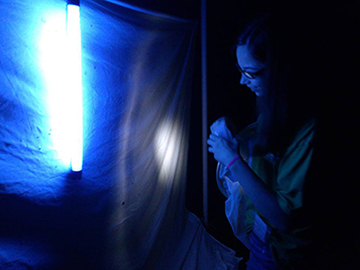|
|
|
Catherine P. MulvaneI am currently involved with projects that focus on butterfly mouthpart (proboscis) functionality and insect biodiversity. The butterfly proboscis is composed to two elongated mouthparts that assemble when the butterfly emerges from the chrysalis, and I am interested in studying how assembly mechanisms differ between distantly related species. I also study the movements of fluids through the proboscis, and its wettability, using a number of different experimental techniques and confocal microscopy. In addition to these studies, I am investigating the insect diversity at the local biopond (Stark Campus) via night collecting. |
 |
Meredith JenkinsI study the feeding behavior of butterflies. The butterfly’s mouthparts consist of two structurally defined parts – a drinking and a nondrinking region. Knowing that fluid uptake is possible along the proboscis (including the nondrinking region), I am trying to determine if butterflies apply more than the drinking region of their mouthparts to liquids when feeding, possibly indicating more efficient feeding. I use a number of different butterfly species in my studies and record their feeding behaviors for these studies. |
 |
Aubrey BrothersI am studying heritability in moth proboscises. Studies in heritability include artificially selecting moths with specific proboscis traits and mating them. I then examine the offspring’s traits to determine if heritability is present. In addition to these studies, I also use color analysis software to study latitudinal trends in wing color of butterfly species from Western North America. |
 |
Eric BrownI am searching for a relationship between butterfly proboscises and the symmetrical arrangements that comprise them. By using the “golden ratio” as a tool for curvature measurements, I am able to show the relationship between curvature of the coiled proboscis and feeding guilds (nectar or sap feeder). This technique provides a new perspective on interdisciplinary applications of mathematics to biology. |

